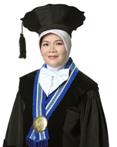
2016 International Conference on Agricultural and Biological Sciences (ABS 2016)
July 23rd - 26th, 2016, Shanghai, China

 |
Prof. Dr. Sri Atun, Department of Chemistry Education, Faculty Mathematics and Natural Science, Yogyakarta State University, Colombo Street No. 1, Depok, Sleman, Yogyakarta, Indonesia, 55281 Professional experience: lecturer in the Department of Chemistry Education, Faculty of Mathematics and Natural Science, Yogyakarta State University, in the field of natural products. Experience research has been done includes the exploration and its activities test as an antioxidant, anticancer, anti-malarial, and antimutagenic several bioactive compounds from plants, especially from the family Dipterocarpaceae, Gnetaceae, and Zingiberaceae |
Speech Title: Phytochemistry some species of indonesian dipterocarpaceae plant from vatica, anisoptera, hopea, and dipterocarpus genera Abstract: In this particular work investigation had been carried out on the secondary metabolites of Dipterocarpaceae species, as well as to determine their bioactivities and biogenetic relationship, namely Vatica pauciflora Blume, Vatica umbonata Burck, Anisoptera marginata Korth, Hopea sangal Korth, and Dipterocarpus grandiflorius Blco. The isolation was carried out by extraction of the powdered plant materials with several organic solvents successively, several steps of fractionation of the extract using a variety of chromatographic techniques, and purification using a combination of chromatographic and crystalization techniques were carried out to isolate the pure compounds. The molecular structure of the isolated compounds were determined based on their spectroscopic data, including ultraviolet, infrared, mass, 1H and 13C NMR. The biological activities of each compound were assayed against Artemia salina Leach, murine leukaemia P-388 cell, and cdk enzyme. Fourteen compounds had been isolated, including twelve resveratrol oligomers, one gallic acid derivative, and one lignan. Two compounds (-)-α-viniferin (7) (IC50 1.4 μg/ml) and (-)-hopeaphenol (10) (IC50 2.9 μg/ml) showed strong activity against murine leukemia cell P-388, however, some compounds showed no activity against cdk enzyme. | |
 |
Prof. Dr. David Eilam, Department of Zoology, Tel-Aviv University,Ramat-Aviv 69978, Israel Dr. Eilam is a professor of zoology in Tel-Aviv University, where he received a career award from the Council for Higher Education in Israel, and he currently heads the laboratory for studies of human and animal behavior. He is also an affiliated researcher at the Interacting Minds Center, Aarhus University, Denmark, and a visiting professor at UNISA, South Africa. His main expertize is in fine-grained analysis of behavior, focusing on the establishment of an image of the physical and social environments in humans and non-humans. Other studies in his laboratory are on rituals and stereotypies, on cultural transmission, and on group formation. He published over 100 papers in refereed journals. For more information about Professor Eilam's research click here: http://david-eilam.weebly.com/ |
Speech Title: Spatial Cognition: The Interaction of the Social and Physical Environments Abstract: Representation of the living space in humans and animals was termed ‘cognitive map’ based on the navigational abilities of rats. Recent studies revealed that spatial representation is also affected by the social environment. While the study of spatial behavior has, for years, focused on behavior of individuals and overlooked the impact of the social environment, recent studies revealed that cognitive maps in the hippocampus extend to the social space. Apparently, solitary animals usually avoid conspecifics while social animals are attracted to their neighbors, and stay or travel together with them, individuals in groups must orient in relation to both the social and physical environments. Accordingly we focus on social spatial behavior, and specifically on how stranger individuals form small groups and explore unfamiliar environments and establish a common living space. By testing spatial behaviour in dyads compared with lone rats, we found that the presence of another rat substantially altered the rats' spatial behavior. Specifically, the social component added complexity to the environment since rats in dyads had to organize their spatial behavior in reference to one another in addition to their organization in the physical surrounding. Consequently, when tested with a partner, spatial behavior was less structured, less predictable and more chaotic. In consequence, it was expected that increasing group size to triads, quartets or octets will result in increased chaoticity, but in factum this was not the case. Spatial behaviour of small groups of rats remains organized by gradual interaction with unfamiliar conspecifics, by establishing social hierarchy of leaders and followers, and by labor division among group members. Altogether, these processes shed new light on the formation and dynamics of small groups and their spatial behaviour. | |
 |
Prof. Dr. Rajamani Raman, Department of Agronomy, Faculty of Agriculture , Annamalai University, Annamalai Nagar- 608 002, Tamil Nadu, India. Dr.R.Raman is an eminent Professor in the Department of Agronomy, Faculty of Agriculture, Annamalai University.He received his B.Sc(Ag), M.Sc(Ag) and Ph.D degrees from AnnamalaiUniversity.He is serving as teaching faculty since 1994. He is teaching Under graduate, Post graduate and Ph.D scholars. He visited more than 15 countries to participate and present his research findings in the International forum. He has served as National Level Monitoring Team member of National Food Security Mission, Government of India.He has received three International award for his outstanding performance.He organized and participated in many National and International conferences as Organizing Secretary /Keynote speaker.He has completed 8 projects and currently there are 4 ongoing projects in his credit as Principal investigator.He has published 3 books and 100 research papers in Journals,Conference proceedings and abstracts. |
Speech Title: Resilience in Agriculture through Crop Diversification: Adaptive Management Strategy for Climate Change under Resource Constraints Condition Abstract: Agriculture is vulnerable to climate change.High temperature ultimately reduces yields of major crops, while encouraging weed and pest population. Changes in rainfall pattern increase the short-run crop failures and long-run production declines. Global warming is a matter of worldwide concern among the most weak areas are the coastal lines of less developed tropical countries such as India. The river deltas, in particular are already facing the brunt of climate change. Due to poor rainfall and late release of water from reservoir,the area under paddy is coming down.The existing traditional crop ie rice may not be viable in the coming years during peak (kuruvai) season because of continuous ground water depletion,change of rainfall pattern,high cost of cultivation and lack of river water flows. The changing scenario of agriculture has forced the farming community to search for an alternate crop, which is more remunerative and viable production portfolio under the resource constraints situation. One rational and cost-effective method may be the implementation of increased agricultural through crop diversification. The diversification of agriculture towards short duration crop with less water requirement has right answer for it, because the alternate crops have great potential of income generation. The great benefits of practising crop diversification can be in the form of contributions to food security,nutritional diversity,income generation,energy supply,plant and disease control,soil fertility,soil conservation,efficient water use and climate change adaptation.This research program aimed to establish viable,sustainable and suitable alternate crop to replace rice under resource constraints conditions. In this field experiment different short duration crops viz corn, finger millet, pearl millet, black gram, green gram, sesame and sunflower were raised. In this experiment, studies have found that all the crops are good alternative crops to rice crop under resource constraints condition. Among the crops tested, the corn crop excelled other crops by recording higher DMP,yield and more economic returns and this was followed by pearl millet. The least yield was obtained from sunflower. The major growth, yield parameters and input efficiency were recorded. Based on the experiment results, crop diversification is seen as an effective measure in strengthening small holder farmers’ resilience to climate change impacts. It is profusely clear from the experiment results that the farmers are facing moisture stress during crop season due to climate change, and that the better implementation of diversified agricultural systems may be a productive way to build resilience into agricultural systems. | |
 |
Prof. Dr. Vladimir Matichenkov, Institute of Basic Biological Problems Russian Academy of Science, Russia Dr. Vladimir V.Matichenkov was born in 1964. In 1986 he graduated Moscow State University, Soil Science department. In 1990 Dr. V. Matichenkov obtained Ph. D. degree (Thesis: Amorphous oxide of silicon in Soddy Podzolic Soils and its influence on plants). In 2008 he defended doctoral dissertation on the title “Role of mobile silicon compounds in plants and soil-plant system”. He works at the Institute Basic Biological Problems Russian Academy of Science. 1998-2004 he worked at the University of Florida. Dr. V. Matichenkov is a specialist in the area of soluble silicon compounds in nature (soil-plant system) and Si fertilizers. Dr. V. Matichenkov is author of more than 140 published materials. Matichenkov organized and conducted numerous seminars in USA, Middle East, Australia, Africa, China, Europe on the theme “Role and functions of Si in the soil-plant system”. In 2004 he organized the international conference “Silicon in Food, Agriculture, and Environment”. In 2015 Dr. Vladimir Matichenkov had obtain Chinese Governmental Award of Friendship (Gold Medal) as Foreign Expert. |
Speech Title: Reduction of pollutant bioavailability in paddy soil of Xiangjiang river basin Abstract: Xiangjiang River is one of the seven mayor tributaries of the Yangtze River. More than 1630 companies and mines whose business is related with heavy metals are located in Xiangjiang River basin. Water and soil contamination by heavy metals in this region has become a threat to food safety and people health. Special national programs have been initiated for resolving environmental problems. Numerous investigations have shown that Si fertilizers can reduce the mobility of heavy metals and metalloids in the soil-plant system. As a result, the accumulation of pollutants in crop is reduced. Six field demonstration tests with several types of Si fertilizers and Si-rich soil amendments were conducted in different areas of Xiangjiang River basin. The levels of soil pollution by As, Cd, Cu, Hg, Ni, Pb, Sb and Se were determined before and after experiments. Main plant bioparameters and yield of rice were measured. Plant tissues were analysed for the total contents of pollutants. The obtained data had shown that the application of tested Si-rich substances (slag from local metal industry and two commercial solid Si fertilizers) significantly increased the rice yield by 10 to 50% and more. Close correlation between the content of soil plant-available Si and rice crop was determined (r=0.80-0.98). The application of Si-rich materials significantly reduced the bioavailability of tested pollutants in the soil and their content in rice. Besides yield, biomasses of the roots, stems, leaves, and hulls were increased under optimization of the rice silicon nutrition. Thus, Si fertilizers of Si-rich soil amendments not only reduce the level of soil and water pollution, but enhance the carbon sequestration on paddy soils. Among other benefits from Si fertilization, remarkable reduction in the level of insect attacks on rice plants was observed. | |
 |
Prof.Dr. EsmatHegazi is Professor of Entomology ,Biological Control Lab, Alexandria,Egypt. University, Egypt Hegazi served as Head of Entomologyfrom 2002 to 2004. He held a postdoctoral positions at the University of Gottingen,1981, Germany. Texas A & M University,1995 , U.S.A. and Cardiff University, Wales,1998, England. Hegazi published 200 scientific articles in the top-ranking journals, and 14 textbooks in entomological sciences Hegazi supervised the training of a good number of graduate students, and enabled 35students to get their M.Sc. and Ph.D. degrees.Hegazi accomplished an outstanding contribution to the Science of applied Entomology, development of integrated pest management in Egypt.Hegazi developed innovative biological and biotechnical methods for a sustainable control system for lepidopterous pests in the Egyptian olive groves.He got several local and international awards. |
Speech Title: Field efficiency of indigenous egg parasitoids (Hymenoptera,Trichogrammatidae) to control the olive moth (Prays oleae,Lepidoptera, Yponomeutidae) and the jasmine moth (Palpitaunionalis,Lepidoptera, Pyralidae) in an olive plantation in Egypt Abstract: The olive tree is long lived ever greentree. It plays an important part in the lives of Mediterranean people.The olive moth, Prays oleae (Bern.), and the jasmine moth, Palpitaunionalis (Hübner), are serious pests in modern olive plantations in Egypt, causing significant yield loss by fruit fall as well as by damage on leaves, flowers and fruits. The egg parasitoid species TrichogrammabourarachaePintureau and Babault, T. cordubensis Vargas and Cabello, T. euproctidisGirault, all collected in olive groves in Egypt, as well as the commercially available T. evanescens Westwood, originating from sugarcane fields in Egypt, were released in several applications in an intensively managed olive plantation for biological control of these pests. Impact of releases was monitored by recording egg parasitism, pest larval densities, fruit damage and fruit yield. Indigenous Trichogrammaspecies accomplished higher egg parasitism (up to 91%) than the commercial strain. Larval densities of target pests were significantly reduced up to 83% on Trichogrammarelease trees in comparison to control trees. Fruit damage ranged below 10% infested fruits and fruit yield was significantly increased on trees where indigenous wasps had been applied. The results suggested that releases of the indigenous T. bourarachae,T. cordubensisand T. euproctidis could improve control of lepidopterous pests on olive.The species T. bourarachaewas most efficient in dispersal and foraging. Not native to this particular olive plantation before, it could sustainably be established after the releases in 2004. The outcome of this field experiment is encouraging for an efficient use of local Trichogramma spp. and represents a starting point for future optimization of the method. | |
 |
Dr. Priyasankar S. Chaudhuri,Professor of Zoology, Tripura University, Kolkata Dr. Priyasankar Chaudhuri (b. 1957), Professor of Zoology, Tripura University (A Central University) did his PG and Ph. D from the Calcutta University, Kolkata. He is an eminent scientist having more than 35 years of research experience in the field of earthworm biology, ecology and organic farming. He has published 78 research papers in National and International Journals of repute. He is the author of the book “KenchorJeevanBaichitra: KenchoPrajukti (1996)” written in Bengali on the biology and ecology of earthworms in north-east India with special emphasis on vermiculture and vermicomposting. He has participated in 20 National symposia and visited Avignon (France) in 1990, Vigo (Spain) in 1998 and Cardiff (U. K) in 2002 to present his research papers in International symposia on Earthworm Ecology. Dr. P.S. Chaudhuri was elected as the Fellow of Zoological Society (FZS), Kolkata (1998) and Fellow of the Society of Applied Sciences, India (2010). His biography has been cited in the Who’s Who in Science and Engineering 2006-2007 (Marquis, USA). The Academic Forum the Society of Earthworm Ecology and Environmental Research (SEEER) has awarded Certificate of Appreciation to him as an Earthworm Biologist in 2012. In 2013, Dr. P.S. Chaudhuri was selected as one of the “Inspiring Teacher of Tripura University, Tripura”. The Foundation for Science and Environment, Kolkata, in association with North Bengal University, West Bengal, honored Dr. Chaudhuri with “Science Excellence Award” in 2015. |
Speech Title: Effects of rubber leaf litter vermicompost on earthworm population and yield of pineapple (Ananascomosus) in West Tripura, India Abstract: Rubber leaves are the abundant agro-waste and pineapple, the most economically important fruit crop in Tripura. So, in our present study, different amounts of rubber leaf vermicompost have been applied to the soils of pineapple plantation to determine their effects on earthworms – the soil ecosystem engineers, coupled with the vegetative growth and yield of pineapples. During 30 months of field trial (2010 - 2012) in ICAR regional station, Lembucherra, West Tripura, the control plot (T0) received no fertilizer, while experimental plots were fertilized with four different amounts of vermicompost viz. T1 (5 tons ha-1yr-1), T2 (10 tons ha-1yr-1), T3 (20 tons ha-1yr-1) and T4 (30 tons ha-1yr-1). A significant (p < 0.05) but gradual increase in density (up to T3 treatment) and biomass (up to T4 treatment) of earthworms were recorded with the increasing amounts of vermicompost. During the second year, average length and width of leaves, number of leaves per plant, plant girth, fruit weight, fruit yield and fruiting percentage were highest in the T3 plot compared to other treated plots and control. The present study reveals that crop yield is very much related to the particular concentration of vermicompost, beyond the level of which production declines and increase in vegetative growth, fruit weight and fruiting percentage of pineapple are strongly linked with the soil pH, av. P, av. K, clay content and the earthworm density of soils. | |
 |
Prof.Dr.Yücel Tekin, Uludag University, Vocational School of Technical Sciences, Bursa, Turkey. Dr.Yücel Tekin was born in 1964, Ankara. He graduated agricultural machinery in Ankara University. He obtained pH. D. from Uludag Universityin 2001.He held a postdoctoral positions at the Cranfield University, UK, 2013. Dr.Yücel Tekin participated several EU projects. His main expertize is determination and mapping of soil properties with on-line vis-NIR soil sensor. Dr. Tekin is currently head of Machinery and Metal Technologies Department. |
Speech Title: On-line Vis-Nir sensor determination of soil variations of sodium, potassium and magnesium Abstract: Among proximal measurement methods, visible and near infrared (Vis-Nir) spectroscopy probably has the greatest potential for determining the physico-chemical properties of different natural resources, including soils. This study was conducted to determine the sodium, potassium and magnesium variations in a 10. Ha field located in Karacabey district (Bursa Province, Turkey) using an on-line Vis-Nir sensor. A total of 92 soil samples were collected from the field. The performance and accuracy of the Na, K and Mg calibration models was evaluated in cross-validation and independent validation. Three categories of maps were developed: 1) reference laboratory analyses maps based on 92 points 2) Full-data point maps based on all 6486 on-line points Vis-Nir predicted in 2013 and 3) full-data point maps based on all 2496 on-line points Vis-Nir predicted in 2015. Results showed that the prediction performance in the validation set was successful, with average R2 values of 0.82 for Na, 0.70 for K, and 0.79 for Mg, average root mean square error of prediction (RMSEP) values of 0.02% (Na), 0.20% (K), and 1.32% (Mg) and average residual prediction deviation (RPD) values of 2.13 (Na), 0.97 (K), and 2.20 (Mg). On-line field measurement was also proven to be successful with validation results showing average R2 values of 0.78 (Na), 0.64 (K), and 0.60 (Mg), average RMSEP values of 0.04% (Na), 0.13% (K), and 2.19% (Mg) and average RPD values of 1.57 (Na) 1.68 (K) and 1.56 (Mg). Based on 3297 points, maps of Na, K and Mg were produced after N, P, K and organic fertilizer applications, and these maps were then compared to the corresponding maps from the previous year. The comparison showed a variation in soil properties that was attributed to the variable rate of fertilization implemented in the preceding year. | |